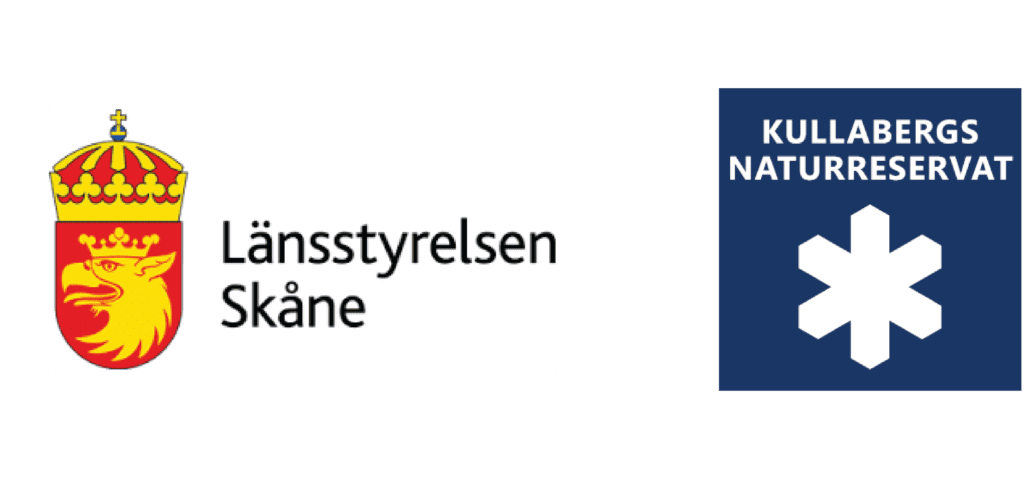TransParcNet 2022 – Binntal Veglia Devero Transboundary Park – Report
The TransParcNet Meeting 2022 was held in “Binntal Veglia Devero Transboundary Park” from June 28th to July 1st. It was hosted by the Binntal Landschaftspark (CH) along with Ente di gestione delle Aree Protettte dell’Ossola (IT) and was the first live TransParcNet Meeting since the COVID pandemic had appeared at the beginning of year 2020.
PARKS AND CULTURAL HERITAGE: Ways to a closer involvement and to better identification of people with their parks.
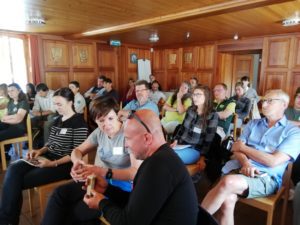
Participants listen to the presentations
Over 30 representatives of EUROPARC’s Transboundary Parks Network, met in Binntal Veglia Devero Transboundary Park from the 28 June to 1 July 2022, to discuss the theme “Parks and Cultural Heritage”. Of course, there was also time to share experiences, ideas and future projects among the Protected Areas of the Transboundary Parks Programme.
The “Binntal Veglia Devero Transboundary Park” is a certified Transboundary Protected Area since 2019. The cooperation between the bordering areas dates back since the early years of the 21st century.
“Binntal and Veglia Devero Parks share not only boundaries and mountains, but also cultures, trading, migrations and heritages.
On both sides of the border, our territories are shaped by a common need which comes from the past and remains alive nowadays: living in the mountains, finding a sound balance between man and natural resources.
These are the driving force that have been designing and painting our transboundary landscapes through the centuries.
Identification of people with the parks, inevitably relies on the ability of reading, understanding and sharing such values.
Shaping the future comes from living the present and knowing the past…”
From the Welcome message from the Boards and Staffs of the Binntal Veglia Devero Transboundary Park
Synopsis of the meeting
On 28th and 29th June, the event took place in Binn, in Switzerland’s part of the Transboundary area, the Binntal Landschaftspark. All presentations can be found at the bottom of this page.
The meeting started with a welcome from the hosts and an update about the Transboundary Parks Programme from EUROPARC’s Stefania Petrosillo. Then, participants heard from the EUROPARC Transboundary Park candidate 2022 Scarpe-Escaut Plain European Nature Park. The representatives, presented the area and their experience as European Group for Territorial Cooperation EGCT. Then Soledad Luna, the special guest and representative of the “Common Wadden Sea Secretariat”, explained the cross-border trilateral cooperation for the protection of a marine and coastal area in the UNESCO World Heritage between Denmark, Germany, and the Netherlands.
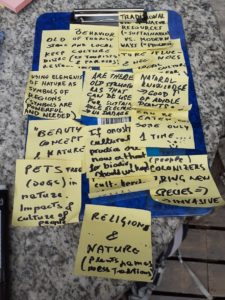
“Walkshop” wrapping up notes
Léa Marie d’Avigneau, culture expert of the Canton of Valais, led the following Round Table on “Cultural Intangible Heritage: experiences and examples from hosts and participants”. This allowed participants to enter the theme of this annual meeting. The works continued during the afternoon with the workshop “What are the cultural links between people and your transboundary parks?”. The day was fittingly concluded with a visit to the local Museum of Archeology and the Etnographic Museum.
Daniele Piazza, Andreas Weissen and Stefania Petrosillo. Photo EUROPARC
Soledad Luna from CWSS gives her speech during indoor morning session. Photo Daniele Piazza
Raymond Zingraff and Lisa Bardot give their speech during the morning session. Photo: Daniele Piazza
Intangible cultural heritage consists of the practices, representations, expressions, knowledge and skills – as well as the instruments, objects, artefacts and cultural spaces associated with them – that communities, groups and, where appropriate, individuals have recognized as part of their cultural heritage for several generations.
– Definition of the concept of intangible heritage by the Law on the promotion of culture in the canton of Valais.
Hackbrett live performance during the morning session. Photo: Daniele Piazza
Ready to visit the Twingy gorge and its art exhibition. Photo: Daniele Piazza
Preparing the raclette. Photo: Daniele Piazza
Cultural heritage in practice
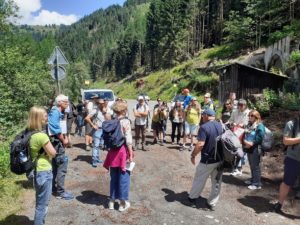
Ready to visit the Twingy Gorge and its art exhibitions, TransParcNet, picture by Daniele Piazza
On 30th and 1st of June, the group moved to Alpe Devero, Italy. At the Museum of “Alpeggio”, the visitor centre of the Park, they had the opportunity to exchange on “Agriculture and mountain dairy as intangible heritage”, with local farmers and with the president of the Park, who is a farmer herself.
An interesting open air working/walking session was organized to combine a visit on the ground and debate with 3 different “Walkshops”: TB protected areas and landscapes; TB protected areas and cultures – including trading and migration; TB protected areas and languages.
The President of Veglia Devero Park Vittoria Riboni presenting her experience as farmer. Photo: Stefania Petrosillo
Getting to know how mountain cheese is produced in Crampiolo, Alpe Devero (intangible heritage and know-how, Bettelmatt cheese) day two. Photo: Daniele Piazza
Our “Walkshop” wrapping-up toolkit, day two. Walking and taking notes at the same time is not that easy…day two. Photo: Daniele Piazza
Visits on the field of beautiful areas of the Transboundary Parks, an open air raclette (a typical culinary product which features melted mountain cheese, potatoes and vegetables) just prepared by the Binntal Landschaftspark staff as well as very testy local food produced by local Alpe Veglia farmers, and informal meeting, songs and leisure time together contributed to reinforce the friendship inside the TransParcNet and made this event very pleasant for everyone.
Conclusions
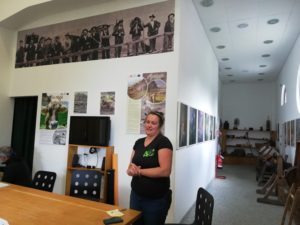
The President of Veglia Devero Park Vittoria Riboni presenting her experience as farmer. Photo: Stefania Petrosillo
The Trans Parc Net Meeting 2022 was intense and inspiring. After 2 years of COVID restrictions and withdrawals, meeting in person was great.
In (post-) COVID time, speaking about nature and intangible heritage makes a lot of sense: there has been a rise in the interest of people, tourists, and visitors in nature and open areas as “safe” places to ensure social distancing, naturally. Nonetheless, we can’t forget that our Transboundary Parks are made by nature and people who cross borders, walk trails, breed animals, migrate and trade. People are attracted not only by natural areas, but more and more by a mix of nature and vital local communities.
Managers should also consider local human dynamics and attitudes when plan and build projects. The TransParcNet participants really believe that some more focus should be put on the linkage among territories and our people in the forthcoming years.
The meeting has efficiently identified the “pillars” of parks and cultural heritage: culture, migrations and trading, languages have proven to be the common drivers of a variety of local processes, and transboundary cooperation should focus on such resources as well as on nature protection at the highest levels achievable.
Presentations
Stefania Petrosillo – Updates on EUROPARC Transboundary Programme
Soledad Luna – Trilateral Cooperation on the Protection of the Wadden Sea
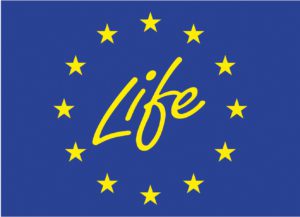
The TransParcNet is made possible thanks to financing through the LIFE Programme of the European Union.
The Kullaberg Nature Reserve Youth+ Experience
In the summer of 2022, Kullaberg Nature Reserve invited two groups of Youth+ to stay, work, learn and share their experiences over the course of two three-week periods. These 9 young people came from Austria, Estonia, Italy, Latvia, the Netherlands, Slovenia, Spain and Switzerland – a very international EUROPARC experience!
Article issued by Moritz Mairl
The Kullaberg Nature Reserve Youth+ Experience
Kullaberg Nature Reserve is located on a peninsula in southern Sweden. and is one of the most visited protected areas in Sweden thanks to its unique landscape, rich biodiversity, and cultural history. Over the course of 3 weeks, the two groups of Youth+ were involved in many different aspects of Protected Area management, incorporating all the four pillars of the Youth+ programme into their work: Nature Conservation, Communication, Leadership and Advocacy.
Nature conservation and recreational space are very close to each other in the area. Visitor management therefore plays a very important role in the Protected Area management. Both Youth+ groups spent many days in the sun, rain and wind, collecting visitor surveys which are used to gather important information about possible conflict points between nature conservation and tourist recreation. These data will be incorporated into a long-term visitor management program. Visitor management also included practical work. For example, we extended a hiking trail with wooden planks to keep visitors on the trail and to protect the vegetation.
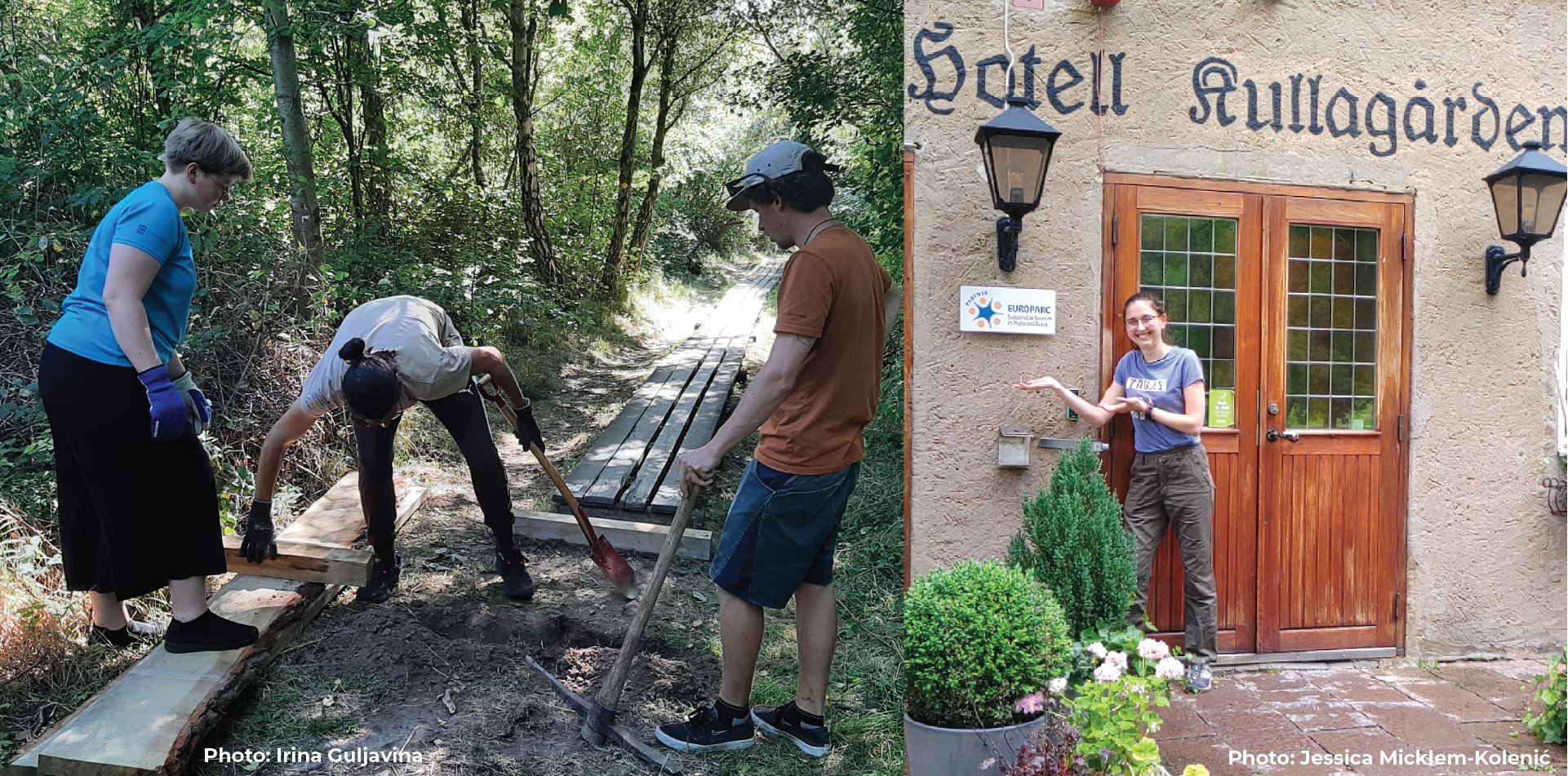
The Youth+ group assisting with trail building and with surveys for the European Charter for Sustainable Tourism
The history of the Nature Reserve is marked by tourism and cultural landscapes. Our meetings with local actors were very informative and brought the history of the region to life. And what better way to talk about the beginnings of the bathing culture in Mölle than during a classic fika (a traditional Swedish coffee and cake break). In the future, the local community plan to be even more involved with the European Charter of Sustainable Tourism, a great way for local businesses and the park to facilitate long-term sustainable development in and around the Protected Area.
While meeting with a local farmer, on the other hand, there was no time for a fika. Sheep had to be unloaded, and the cultural landscape that has been maintained for centuries should continue to be preserved. Even if the work is now only financially viable through subsidies, the cultural heritage is preserved and by working with old native breeds of sheep and cows, the farmer contributes to the promotion of biodiversity. A work that should receive far more recognition and access to financial support.
Nature is also changing in Sweden. Invasive species threaten the native flora and fauna. To curb the problem, the Youth+ assisted with both tangible actions (uprooting invasive plants) and education of the local community and tourists. At the same time, new habitat have been created for rare native species. Due to a lack of deadwood in the forest, bats find it difficult to find enough nesting holes. To counteract this problem, the International Youth+, the local Youth+ and the Kullaberg Junior Rangers have been building some bat houses and installed them in the forest. We hope for numerous inhabitants!
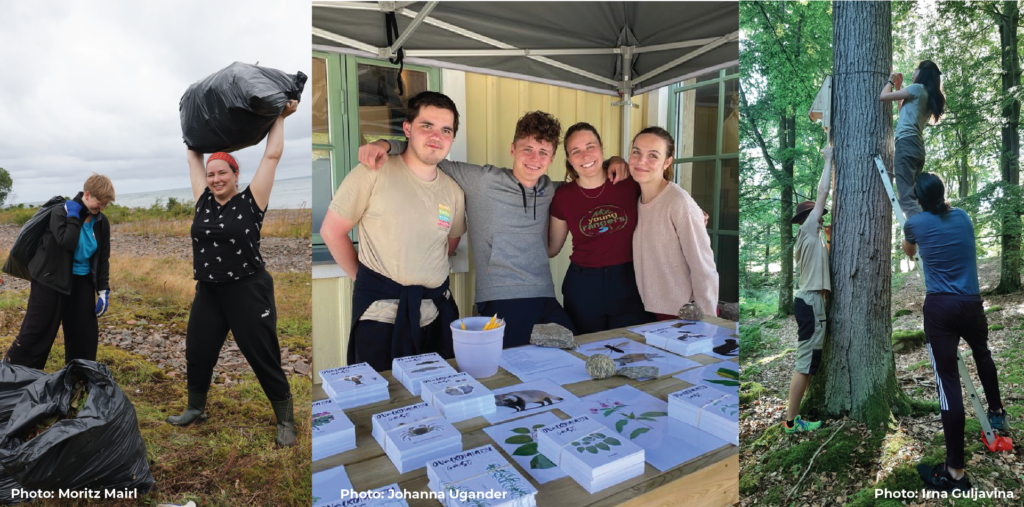
The Youth+ eradicated invasive species, helped raise awareness about their danger to local species, and put up bat houses for conservation.
The Kattegat Strait between Denmark and Sweden is one of the busiest shipping routes in the world. This became very clear when looking out from the lighthouse, the landmark of the nature reserve. Nevertheless, many sea creatures feel extremely comfortable around the peninsula. Lessons about the marine and shoreline life in the area allowed the Youth+ to better understand the biodiversity of the region and experience it first-hand, whether in the Naturum (the visitor centre), while snorkeling or during a Porpoise Safari. Even garbage collecting became an exciting job when you can search for garbage in a kayak or boat along the impressive cliffs!
The Kullaberg Nature Reserve offers enormous diversity in a relatively small area. The participants, each of whom has already gained experience in Protected Areas in their home countries, appreciated this. But what about the young people in the region around the nature reserve? This question was explored in a design thinking workshop.
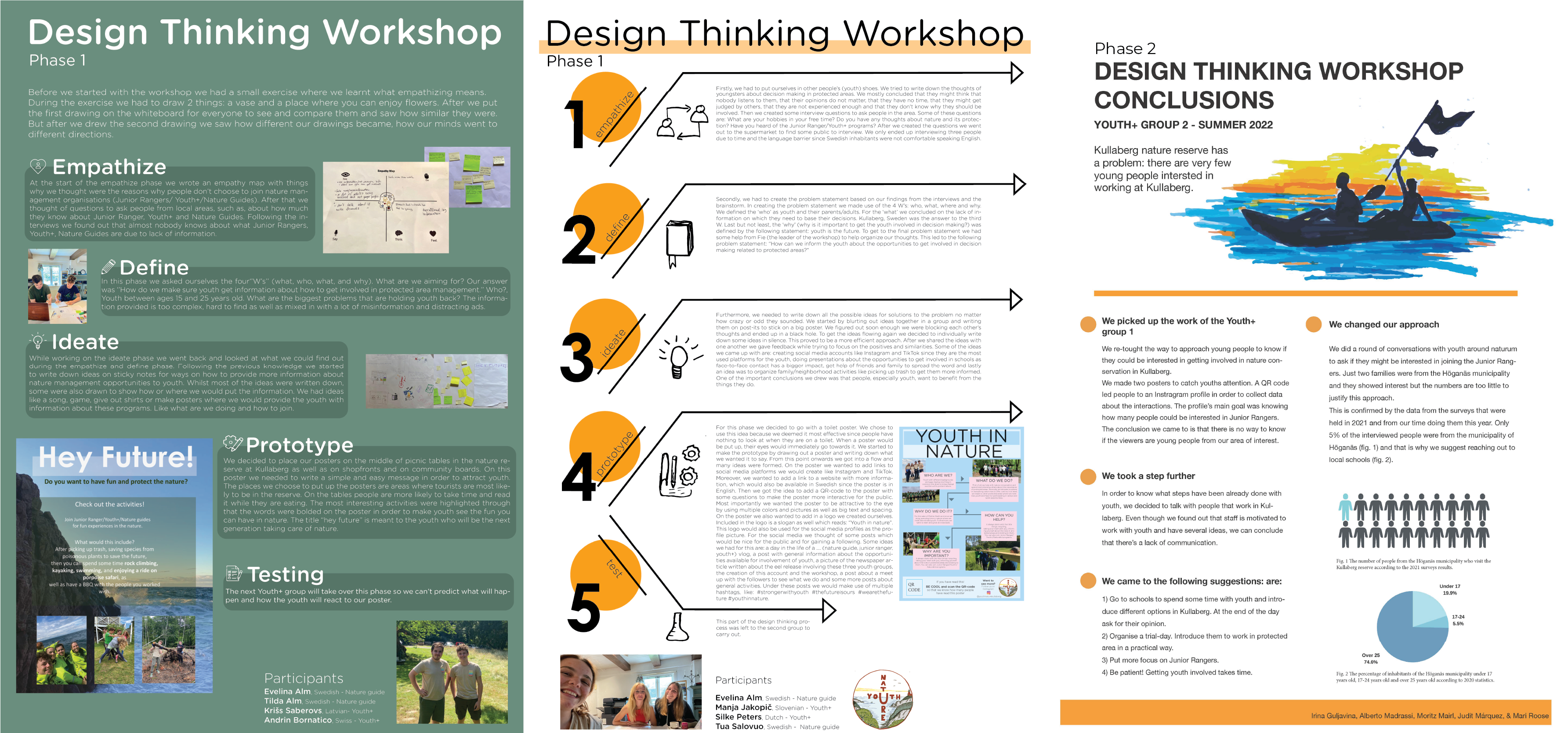
The three posters explaining the Design Thinking Process of Groups 1A, Group 1B (both doing Phase 1) and Group 2 (doing Phase 2)
You can download them here:
Group 1A: Process & Poster
Group 1B: Process & Poster
Group 2: Process & Poster
The Youth+ groups worked together with the local Naturvärdar (a local seasonal youth workers in Kullaberg Nature Reserve), following the design thinking process to evaluate how the Protected area could engage more young people. The first group of Youth+ started the process by interviewing local teenagers and young adults. As a group, problems were recorded, new solution-focused strategies were developed and tested. Posters were used to make young people in the nature preserve aware of what opportunities exist for participation. Interactions with the posters were then tracked on social media using QR codes. The results were evaluated together. Design thinking is a non-linear process that involves setbacks and many questions. For example, the poor interaction with the posters led to some frustration, but also to the development of new solutions and strategies.
The second Youth+ group then continued the design-thinking process to look at how young people can be better reached and what it takes to keep them involved in the park’s work. As an outcome of the workshop, posters and scripts were developed, which present strengths, weaknesses and possible courses of action for Kullaberg Nature Reserve. This should help the management of the reserve to be more active in the field of youth work in the future. Since Kullaberg Nature Reserve is considered the flagship for EUROPARC youth programs in Sweden, in the best case this can have an impact on the whole country!
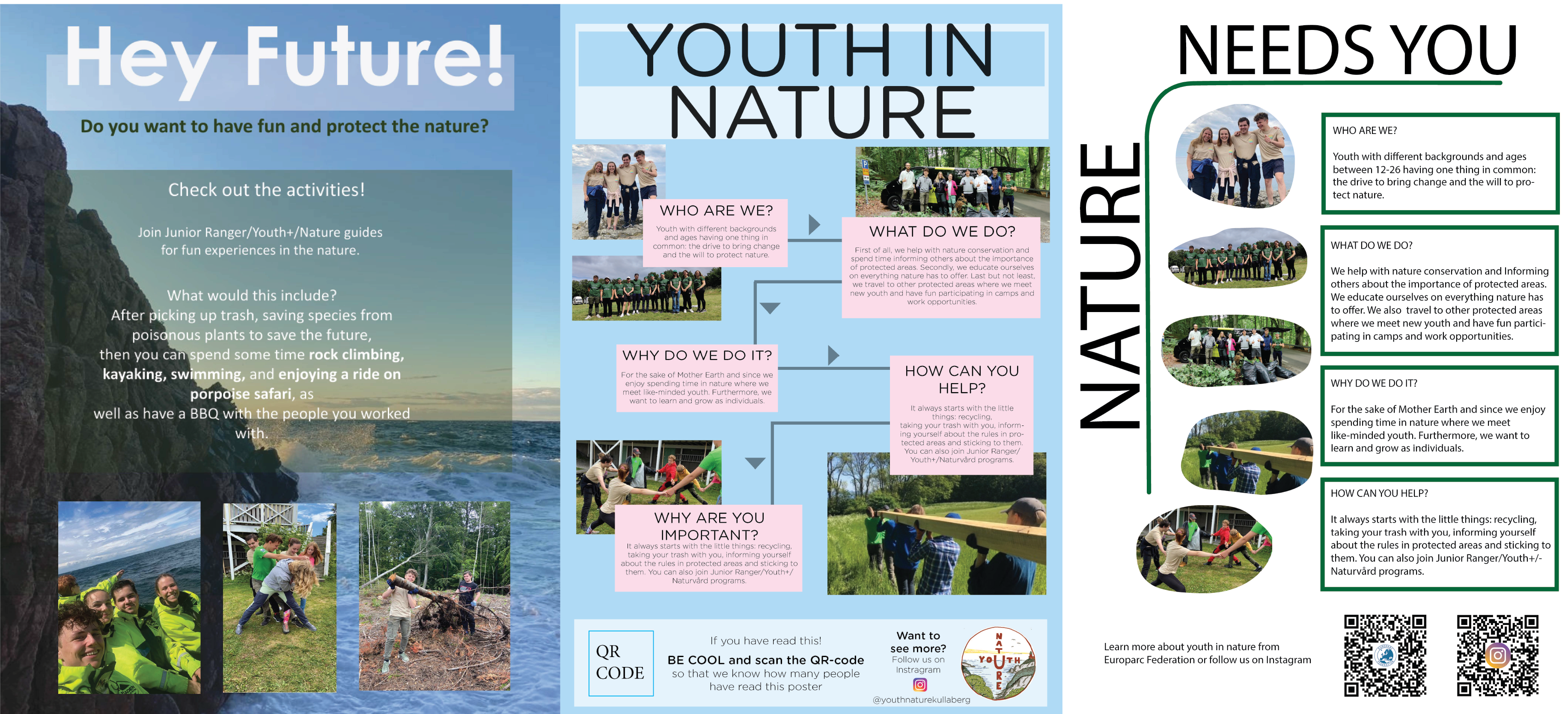
Advertising youth engagement in Kullaberg Nature Reserve
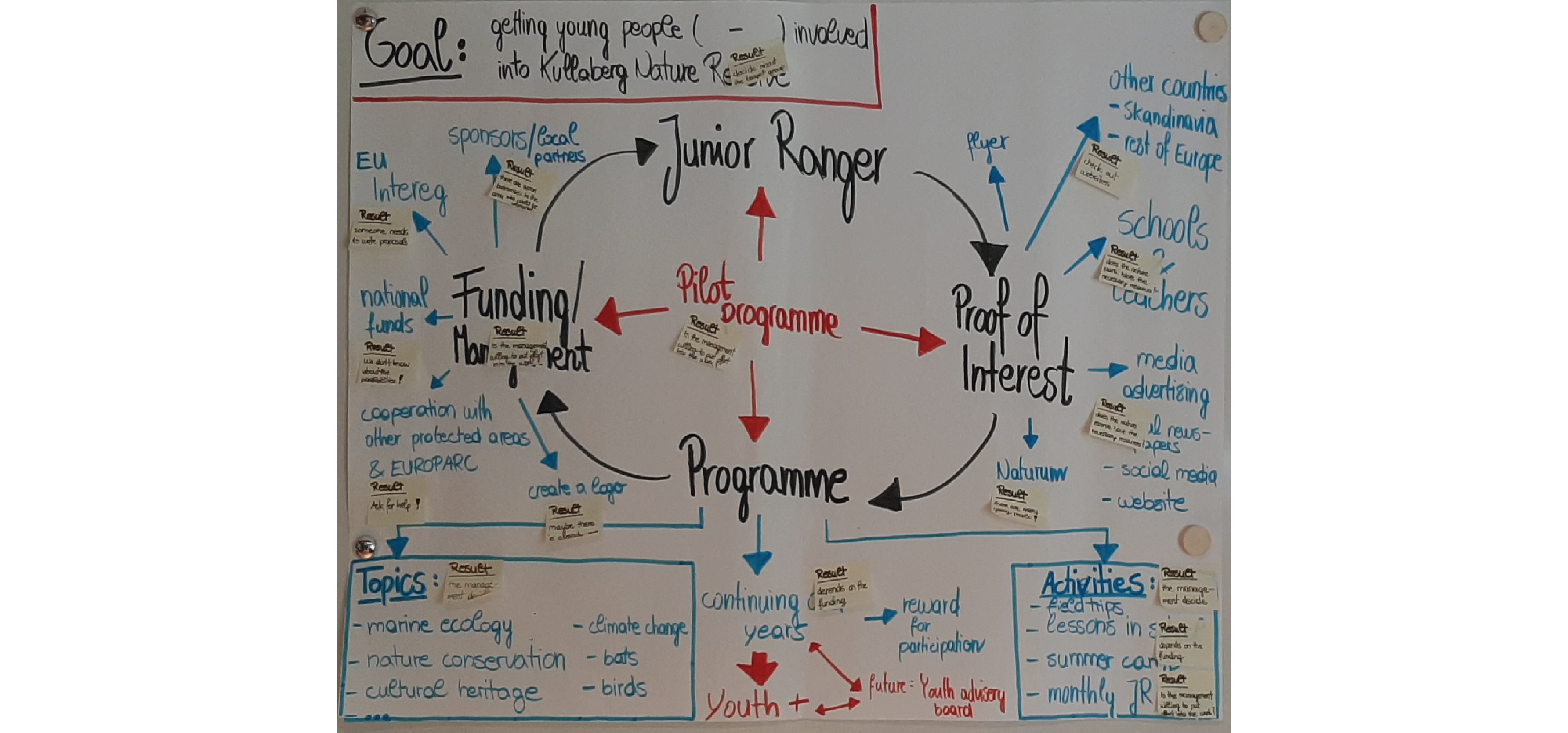
A diagram of the youth involvement process at Kullaberg Nature Reserve
At the end of the three weeks, each of the Youth+ participants prepared a presentation of their home Protected Areain which they had already gained experience. The local staff, Youth+ and Junior Rangers were excited to hear how other Protected Areas were running their Junior Ranger and Youth+ programmes. The audience was eager to travel and experience this first-hand, and plans were made to travel together.
In addition to the insights into the work of the Protected Area, there was also time to get to know Sweden better. Some participants visited Gothenburg, Lund, Malmö, Helsingborg and thanks to the proximity to Denmark also Helsingør. Not only cities, but also the other nature reserves of southern Sweden were explored. The notorious bathing culture became a social event during the early morning swim. To recover from the cold of the sea, the sauna in the accommodation was heated up several times in the evening. The participants also used their free time to better explore the surrounding area. Lonely bays, breathtaking sunsets and jumping tunas were among the absolute highlights here. Barbecue evenings, cooking together (seaweed pasta, köttbullar and much more), a crayfish party, movie nights and karaoke swore the participants together to a team and made the time in Sweden fly by and new friendships developed. Nobody will forget this great time so quickly!
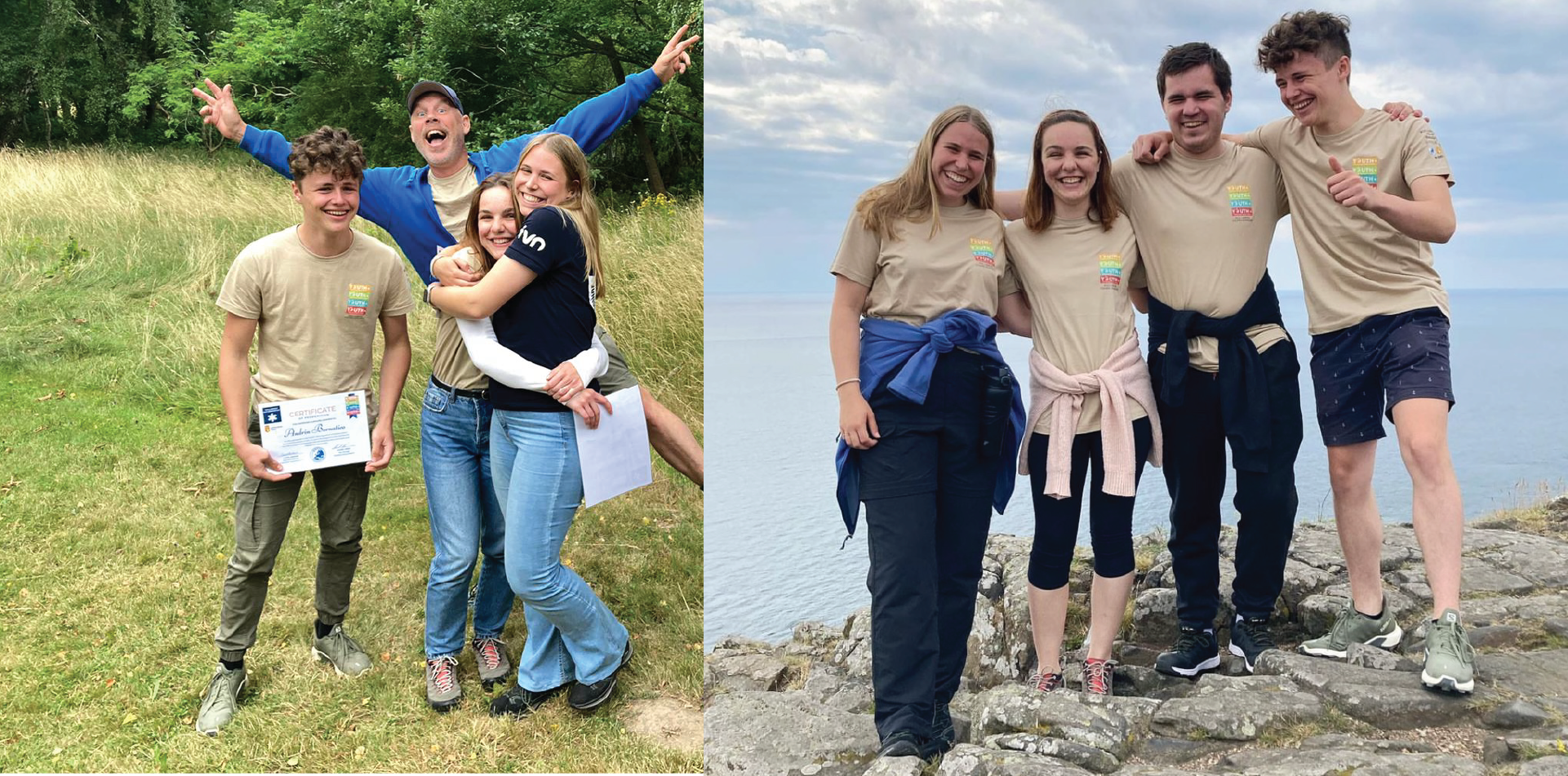
The first group: Silke Peters (NL), Manja Jakopič (SI), Krišs Atvars Saberovs (LV), and Andrin Bornatico (CH)
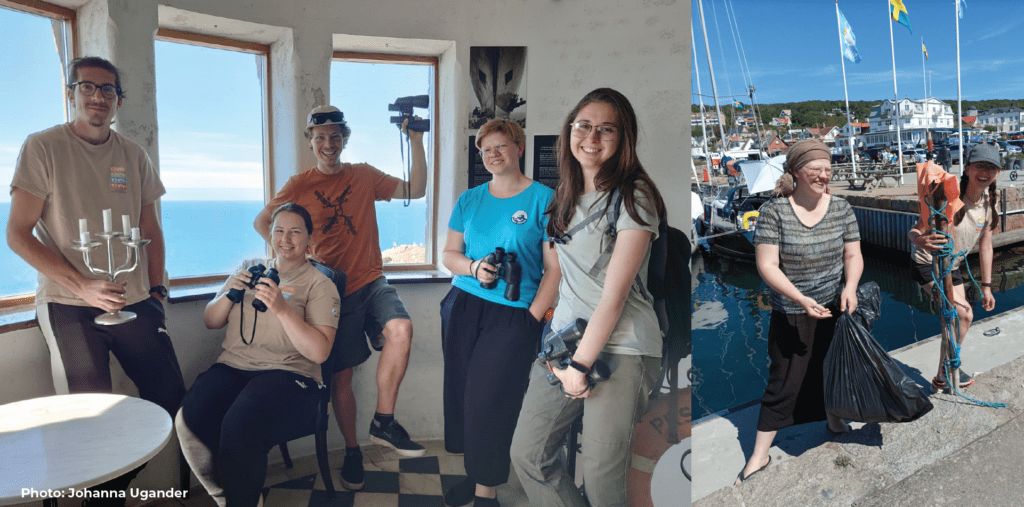
The second group: Alberto Madrassi (IT), Irina Guljavina (EE), Moritz Mairl (IT/AT), Mari Roose (EE), and Judit Márquez Pérez (ES),
This work was supported by:

